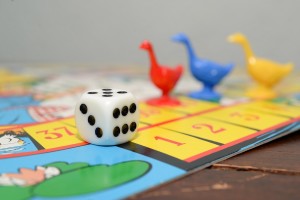Teaching Multiple Levels
 Twelve four-year-olds, two-thirds of which are speakers of other languages gathered in the toys and games center to learn a new game. I had a small mat, a large foam die, and colored craft buttons. I chose a child at random to help demonstrate but it couldn’t have been a better choice. He is my late bloomer and needed a boost of confidence. We were going to roll the die, count out the buttons on the mat in parallel lines and compare who had the most. Naturally, the one with the most would be the winner.
Twelve four-year-olds, two-thirds of which are speakers of other languages gathered in the toys and games center to learn a new game. I had a small mat, a large foam die, and colored craft buttons. I chose a child at random to help demonstrate but it couldn’t have been a better choice. He is my late bloomer and needed a boost of confidence. We were going to roll the die, count out the buttons on the mat in parallel lines and compare who had the most. Naturally, the one with the most would be the winner.
Braydon rolled first. “Three!” the class shouted. He couldn’t yet recognize a group of three. He touch-counted the dots. “One, two, five.”
“Let’s try again.” I helped him count three dots. He placed three large buttons on the mat. Now it was my turn. I rolled a two and placed two buttons on the mat parallel to Braydon’s creating a graph. “Braydon, who won?” He looked at me with big questioning eyes. “You won!” I said. We had recently read Pete the Cat and His Four Groovy Buttons”. I looked at the class, “Did I cry? Goodness no. Buttons come and buttons go. Braydon, let’s play again.”
This time Braydon rolled a six. I helped him touch count the dots again but the class was noticing something more. I slid the mat against the oversized die so Braydon could easily match the buttons to the dots on the die.
“Hey, That’s three and three!” Ben said.
Then Mila joined in, “Three and three more is six.” These two were subitizing and beginning to add. Others were pointing toward the die counting dots in the air to see if Ben and Mila’s summations were correct. The class was using the game at their level and extending their personal knowledge. Braydon paid the class no attention as he concentrated on matching buttons to dots making his line on the mat. My turn to roll again. I rolled a three. I placed my three buttons parallel to Braydon’s six.
“Braydon, who won?” I asked.
“Braydon did!” the class answered. He grinned from ear to ear as I turned to the class.
“Did I cry?”
“Goodness no.” They all shouted. “Buttons come and buttons go.” Braydon was learning to count and match. Others were learning to read a graph, subitize, and some were even learning to add. All the children made connections to literature, joined in choral speaking and began learning the social concepts of taking turns and sometimes we lose.
This type of lesson is adaptable in not only classrooms but to homeschooling with multiple age children. It will save planning time and teaching time.
Another day Ben and a friend wanted to use the magnetic letters to make their names and other words. I had a metal tray and a removable copy of the alphabet, a box of upper case and lower case letters and word cards. Posters with easy reader stories were displayed around the library area where we were working. Ben found his B and was rummaging through the letter box for more letters. I showed him and his friend how to sort the letters using the alphabet tray. Others came over to join in. Ben’s friend and the others were more interested in sorting and stacking, naming the letters for each other or asking me letter names and yelling out, “I found my letter. Here’s my name (meaning beginning letter).”
Ben wanted to write something. We found a simple sentence on a poster. He used the magnetic letters to make the sentence, then copied it onto paper. All the children were working with the same materials at different levels making gains at their own pace. Most of the children have limited English so all the talking and interacting was building language skills and Ben who is also an English language learner was learning to read while writing.
Too often we pigeon hole subjects instead of allowing everything to flow together – like real life.
I’d love to hear about your teaching experiences to add to my pocket of ideas and strategies.

I love how there are so many wonderful ways to teach our children. 🙂
Fascinating! I would have loved to have been there to see the interaction and participate with them.